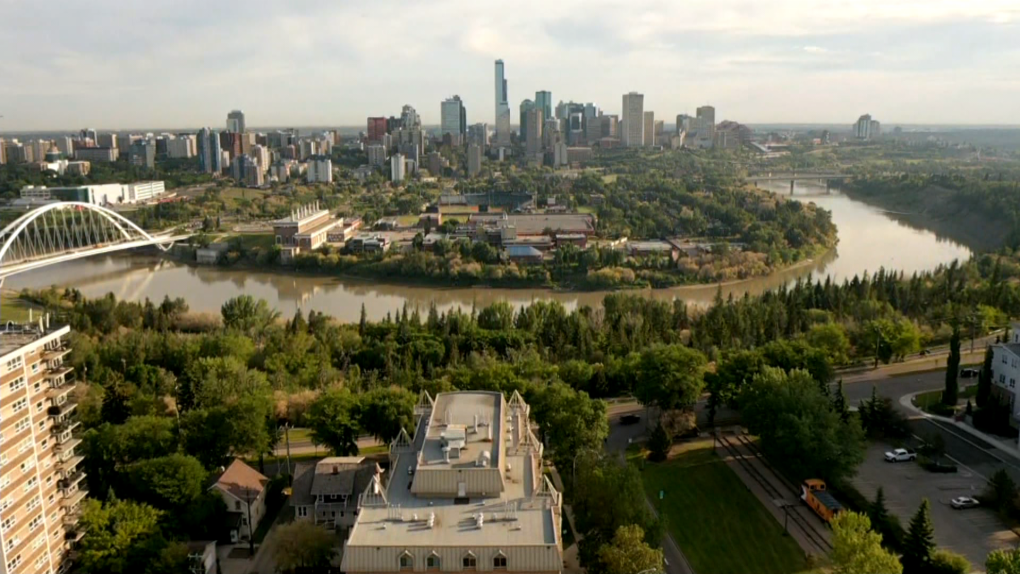Edmonton may be known for winter chill, but heat islands on the rise, researchers say

Researchers at the University of Alberta say a city known for its bone-chilling winter temperatures also has potentially dangerous heat islands that have been getting hotter for the last two decades.
The heat-island effect measures the difference in surface temperature between urban and rural areas, said Sandeep Agrawal, a professor in the university's Faculty of Science.
It has been closely investigated in eastern cities such as Montreal and Toronto, he added.
"A winter city like Edmonton has not been studied for this phenomenon and we did not know if it was occurring here," Agrawal said in a recent interview.
"The big takeaway is Edmonton also experiences urban heat-island effect. This could be deadly for people during summer months, from headaches, to heatstroke, to even heat-related mortality like what we saw in B.C. last year where hundreds of people died.
"The deaths are attributed to heat islands."
The research, co-authored by post-doctoral researcher Nilusha Welegedara, is under review for publication.
Agrawal said Edmonton has numerous areas where the temperature of the ground has jumped by between 6 C and 12 C overall compared to rural areas over the past 20 years — and it's due to global warming and a loss of vegetation.
"Cities are getting more and more paved over with concrete and surfaces that absorb heat at the expense of vegetation," he said.
Agrawal and his team analyzed satellite images between 1999 and 2021 and examined 402 neighbourhoods, including industrial areas, residential areas and the North Saskatchewan River Valley, which stretches through the city and is one of largest urban parks in North America.
The study found the north side of the city and some downtown areas with low vegetation had higher temperatures than the south side, which was cooler because of the river valley and older neighbourhoods with features such as boulevard trees.
"Literature does say that heat exposure is much more pronounced among people who are marginalized and vulnerable, " he said.
"What we saw was that the neighbourhoods along the River Valley are cooler, and they're also occupied by people of a higher socio-economic status. So you can say that … it's the lower-economic status people who are a lot more affected by it."
Agrawal said the city's urban planning needs to take into account the hot summers that are becoming common along with cold winter weather.
“Cities like Edmonton have long focused on their identities as winter cities. I believe Edmonton’s identity is changing as the temperature rises over the years,” Agrawal said.
"When we are building new neighbourhoods, there needs to be some way of preserving vegetation and trees so that we can mitigate this effect as much as we can," he said.
The study also discourages the use of materials such as concrete and asphalt because it absorbs more heat.
"There are alternate material pavers available that can help," he said.
Agrawal said his team is now researching a similar trend in Calgary and Vancouver.
"Canada is supposedly a winter country. Edmonton especially is considered a winter city, but that's not the case anymore when you're talking about the urban heat-island effect."
This report by The Canadian Press was first published Aug. 31, 2022.
This story was produced with the financial assistance of the Meta and Canadian Press News Fellowship.
CTVNews.ca Top Stories

BREAKING Police to announce arrests in Toronto Pearson airport gold heist
Police say that arrests have been made in connection with a $20-million gold heist at Toronto Pearson International Airport one year ago.
LIVE @ 4 EDT Freeland to present 2024 federal budget, promising billions in new spending
Canadians will learn Tuesday the entirety of the federal Liberal government's new spending plans, and how they intend to pay for them, when Deputy Prime Minister and Finance Minister Chrystia Freeland tables the 2024 federal budget.
Proposed class-action lawsuit against Shoppers Drug Mart alleges 'unsafe and unethical corporate practices'
Shoppers Drug Mart is facing a proposed class-action lawsuit by current and former franchise owners at the retail chain who allege parent company Loblaw engaged in corporate practices that placed them in an “irredeemable conflict of interest” and put patient care at risk.
Lululemon unveils first summer kit for Canada's Olympic and Paralympic teams
Lululemon says it is combining function and fashion in its first-ever summer kit for Canada's Olympians and Paralympians.
Outdated cancer screening guidelines jeopardizing early detection, doctors say
A group of doctors say Canadian cancer screening guidelines set by a national task force are out-of-date and putting people at risk because their cancers aren't detected early enough.
Canada's health-care crisis was 'decades in the making,' says CMA
The strain placed on Canadian health care during the COVID-19 pandemic shows no sign of abating, and the top official of the Canadian Medical Association (CMA) is warning that improving the system will be a 'slow process' requiring sustained investment.
'I just started crying': Blue Jays player signs jersey for man in hospital
An Ontario woman says she never expected to be gifted a Blue Jays jersey for her ailing husband when she sat alone at the team’s home opener next to a couple of kind strangers.
Mussolini's wartime bunker opens to the public in Rome
After its last closure in 2021, it has now reopened for guided tours of the air raid shelter and the bunker. The complex now includes a multimedia exhibition about Rome during World War II, air raid systems for civilians, and the series of 51 Allied bombings that pummeled the city between July 1943 and May 1944.
B.C. woman facing steep medical bills, uncertain future after Thailand crash
The family of a Victoria, B.C., woman who was seriously injured in an accident in Thailand is pleading for help as medical bills pile up.































